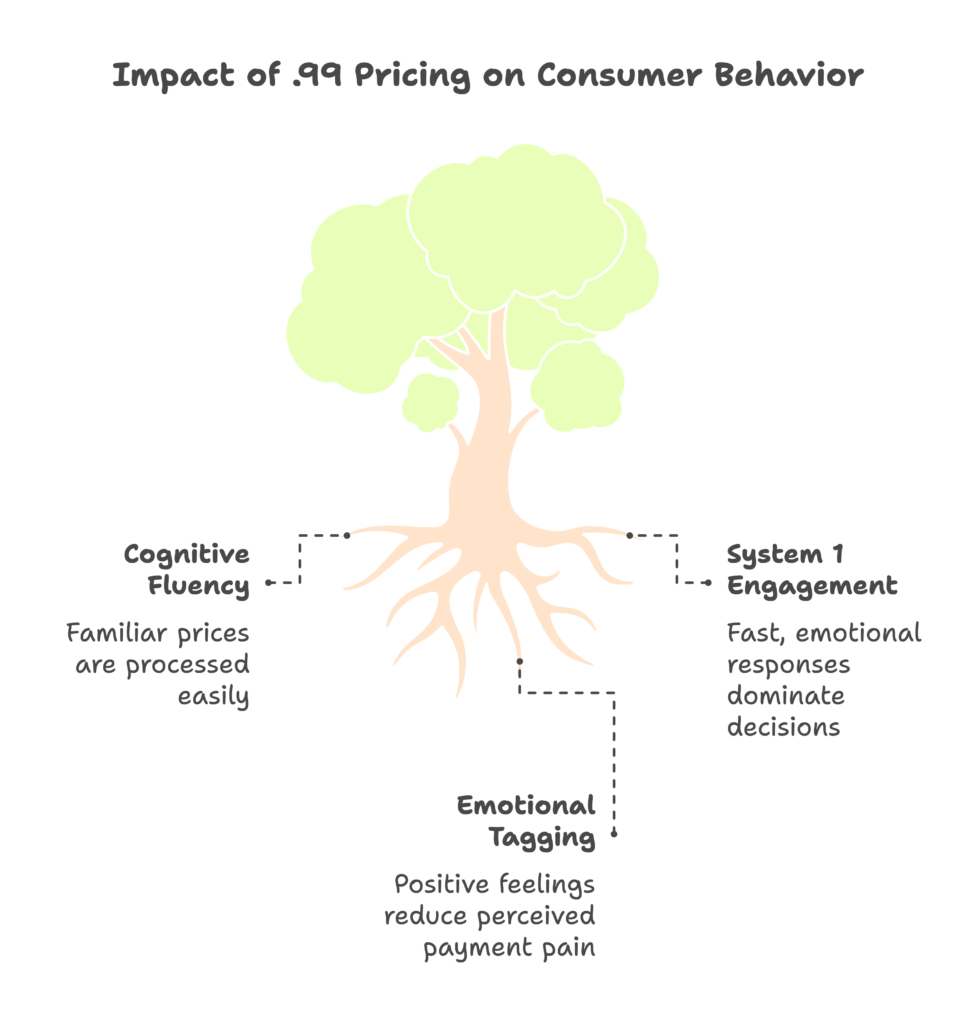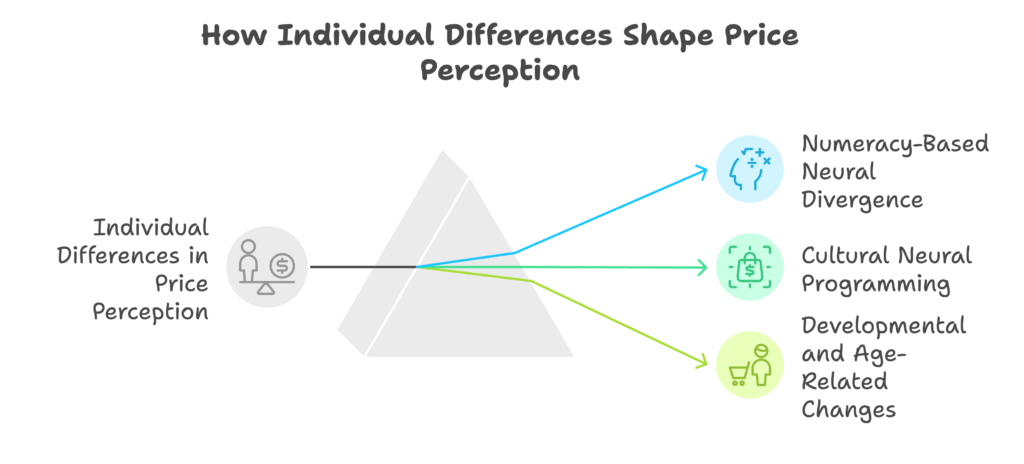When you see $9.99 instead of $10, your brain processes these numbers differently than you might expect. It’s not just marketing folklore – it’s neuroscience. By the end of this article, you’ll understand:
- How your brain actually processes price information
- The neural mechanisms that make .99 pricing so effective
- Why different people respond differently to these pricing tactics
- How companies measure and implement these strategies
- The future of neuromarketing and pricing psychology
Ready to peek inside your own brain and understand why a 1-cent difference can have such a huge impact on your buying decisions? Let’s dive in!
Neurocognitive Foundations of Price Perception
Before we understand why .99 pricing works so well, we need to explore how our brains process numerical information in the first place. This foundation will help you understand the fascinating neural dance that happens every time you see a price tag.
Neural Encoding of Numerical Stimuli
When you look at a price, your brain doesn’t process it as a single unit. Instead, it activates a complex network across different brain regions. This network includes:
- The prefrontal cortex: The part of your brain responsible for decision-making and higher thinking
- The parietal lobe: Where mathematical processing happens
- The ventral visual pathway: How your brain visually recognizes numbers
These three regions work together in what scientists call the “triple-code model” of number processing. But there’s more! The intraparietal sulcus is particularly important for understanding the actual size or magnitude of numbers. Meanwhile, emotional areas like the nucleus accumbens and insula help determine how you feel about prices.
Left-Digit Effect Neural Correlates
The “left-digit effect” is what makes $9.99 feel significantly cheaper than $10.00, even though the difference is just one penny. When your brain processes these prices, several interesting things happen:
- Your occipital cortex (visual processing area) shows biases toward the first digit you see
- Your anterior cingulate cortex detects the “conflict” between the actual mathematical difference (tiny) and the perceived difference (significant)
- Your dorsolateral prefrontal cortex activity is affected by price anchoring, where the first number you see becomes a reference point
In simpler terms, your brain gives special importance to the leftmost digit (the 9 in $9.99), creating an outsized perception of savings compared to $10.00.
Neurochemical Mediators
It’s not just brain regions that matter – specific neurochemicals also play crucial roles:
- Dopamine: The “reward chemical” that gives you a little thrill when you find what seems like a good deal
- Noradrenaline: Helps modulate your attention when comparing prices
- Oxytocin: Can increase trust responses to pricing that feels familiar and fluent
These chemicals create the emotional backdrop for how we experience prices. That little hit of dopamine when you see “$9.99” instead of “$10.00” can be enough to push you toward making a purchase.
Now that we understand how our brains generally process prices, let’s dig deeper into the specific neural mechanisms that make .99 pricing so effective. Ready to see how those crafty marketers are playing with your neural networks?
Neural Mechanisms of .99 Price Processing
Now that we understand the basic brain regions involved in price processing, let’s zoom in on exactly how your brain responds to those .99 price endings. These mechanisms explain why such a tiny price difference can have such a significant impact on your purchasing decisions.

Cognitive Fluency Pathways
Your brain loves to process information that feels familiar and easy. This “cognitive fluency” plays a big role in how we respond to .99 pricing:
- Your brain’s default mode network activates more for familiar price endings like .99 or .95
- The perisylvian language network (which helps with language processing) engages when encoding verbal representations of prices
- Your hippocampus, crucial for memory, completes patterns for familiar pricing schemas
Simply put, we’ve seen .99 prices so often that our brains process them more easily. And when something is easier for your brain to process, you tend to feel more positive about it, even if you’re not aware of this happening!
Dual-Process Neural Dynamics
When you encounter a price, your brain engages two different types of thinking:
- System 1 (located primarily in the ventromedial prefrontal cortex): Fast, automatic, and emotional processing
- System 2 (centered in the dorsolateral prefrontal cortex): Slow, deliberate, and logical processing
The brilliance of .99 pricing is that it primarily targets System 1. When you’re busy shopping, under cognitive load, your System 2 often doesn’t engage fully to realize that $9.99 is essentially the same as $10. Meanwhile, your insula (which processes the “pain of paying”) shows less activity for .99 prices, making purchases feel less financially painful.
Emotional Tagging Mechanisms
Prices aren’t just numbers – they’re emotional experiences. Several emotional tagging mechanisms occur with .99 pricing:
- Your amygdala (the emotional center) shows increased response to perceived savings
- Your ventral striatum activates during “deal recognition,” creating positive feelings
- Your anterior insula, which normally signals the “pain of paying,” shows reduced activity with .99 pricing
These emotional responses happen quickly and largely unconsciously. That’s why even when we know that $19.99 is basically $20, we still feel like we’re getting a better deal.
The neural mechanisms we’ve discussed so far apply generally to most people, but what about individual differences? We’re not all affected by .99 pricing in exactly the same way. Let’s explore why your brain might respond differently than someone else’s…
Individual Differences in Neural Processing
Now that we understand the general neural mechanisms behind .99 pricing, let’s explore why this pricing strategy might affect you differently than your friend or family member. Our brains aren’t all wired exactly the same way, and these differences matter when it comes to how we process prices.

Numeracy-Based Neural Divergence
People with different levels of mathematical ability process prices differently:
- Those comfortable with math show more precuneus activation (a brain region involved in complex calculations)
- The parietal lobe (important for numerical processing) engages differently based on mathematical skills
- Working memory capacity affects how accurately people recall and compare prices
If you’re very comfortable with numbers, you might be less susceptible to .99 pricing tricks because your brain more easily converts $9.99 to “essentially $10.” But even mathematically skilled people can fall for these pricing strategies when they’re not paying full attention!
Cultural Neural Programming
Our cultural background significantly shapes how our brains process prices:
- Reading direction (right-to-left vs. left-to-right) affects how we visually process prices
- Different currency formats can change how our brains encode the magnitude of prices
- Collectivist vs. individualist cultural backgrounds influence valuation patterns
For example, in cultures where price bargaining is common, the brain might process .99 pricing differently than in fixed-price cultures. These cultural neural differences develop over years of exposure to specific pricing norms and practices.
Developmental and Age-Related Changes
Our brains change throughout our lives, affecting how we respond to pricing strategies:
- Adolescents with still-developing prefrontal cortexes may be more susceptible to pricing tricks
- Older adults might experience dopaminergic decline that changes their susceptibility to “deal” perceptions
- Neuroplasticity (the brain’s ability to form new connections) affects how we form price expectations over time
This explains why your grandparents might respond differently to sales and pricing strategies than your teenage cousins. Their brains are literally processing the information differently based on developmental stage!
Understanding these individual differences is fascinating, but how do companies actually measure these neural responses to optimize their pricing strategies? Let’s explore the cutting-edge tools that reveal what’s happening in your brain when you shop…
Measurement Techniques in Pricing Neuroscience
Scientists and marketers aren’t just guessing about how our brains respond to prices – they’re actually measuring these responses directly! Let’s look at the fascinating tools researchers use to peek inside our heads and understand our reactions to different pricing strategies.
fMRI Insights
Functional Magnetic Resonance Imaging (fMRI) is one of the most powerful tools for understanding brain responses to pricing:
- It measures blood oxygen level-dependent (BOLD) signals during price evaluation
- Allows researchers to map blood flow patterns as people consider different prices
- Can analyze connectivity between brain regions during price-quality tradeoff decisions
For example, researchers might show participants products at different price points (like $9.99 vs. $10.00) while they’re in an fMRI machine. They can then see which brain regions activate more strongly for each price point, providing direct evidence of the neural basis for pricing effects.
EEG Applications
Electroencephalography (EEG) measures electrical activity in the brain and offers several advantages for pricing research:
- It can detect N400 components (brain responses) when we encounter unexpected or incongruous prices
- Measures frontal theta oscillations that occur during price deliberation
- Records alpha and beta band power changes that can predict purchase intent
EEG is less expensive than fMRI and allows for more movement, making it useful for more realistic shopping scenarios. It’s particularly valuable for understanding the timing of brain responses to prices – which happens in milliseconds!
Multimodal Approaches
The most advanced research combines multiple measurement techniques:
- Eye-tracking combined with fMRI can map where people look when evaluating prices and what brain activity occurs simultaneously
- Galvanic skin response (measuring subtle sweat changes) can be correlated with insular activity (the brain’s “pain of paying” center)
- Machine learning algorithms can fuse neural and behavioral data to create powerful predictive models
These multimodal approaches provide a more complete picture of how we process prices, from conscious attention to unconscious emotional responses and neural activity.
Now that we understand how researchers measure these effects, let’s explore how companies actually put this knowledge to use. How can businesses apply neuroscience to develop more effective pricing strategies? Let’s find out…
Strategic Implementation Frameworks
With all this fascinating brain science, you might be wondering: how do companies actually use this information? Let’s explore the practical applications of neuromarketing in pricing strategies – the frameworks that businesses use to influence your purchasing decisions.
Optimal Price Ending Selection
Not all price endings work equally well for all products. Companies use neuroscience to determine the best approach:
- They analyze category-specific neural response profiles (luxury products vs. everyday items)
- Study price tier boundary neurosensitivity (when a price crosses a significant threshold like $10 to $9.99)
- Research competitor price neural priming effects (how seeing one price affects perceptions of another)
This explains why some products use .99 endings, while others might use .95 or even round numbers. For luxury goods, precise numbers like $1,499 might trigger “bargain” centers in the brain, reducing perceived quality, so round numbers like $1,500 are often better.
Contextual Enhancement Tactics
Price doesn’t exist in isolation – the context dramatically affects neural processing:
- Color and typography choices can be paired with specific pricing to enhance neuroaesthetic impact
- Decoy pricing strategies engage the prefrontal cortex in ways that make target prices more attractive
- Scarcity messaging (“only 2 left!”) can activate the amygdala, creating emotional urgency
Have you noticed how sales tags are often bright red? That’s because red creates arousal and urgency in the brain, enhancing the impact of the price reduction. These contextual elements work together with price endings to maximize neural impact.
Cross-Channel Consistency
As shopping becomes increasingly omnichannel, companies must consider how prices are processed across different environments:
- Neural priming effects differ between rounded prices ($10) and precise prices ($9.99)
- Price presentation can be optimized for multisensory impact (visual, auditory, etc.)
- Mobile vs. desktop shopping environments create different neural processing dynamics
For instance, studies show that on smaller mobile screens, the left-digit effect of .99 pricing might be even stronger because the price appears more compact, making the first digit even more salient to your brain.
While these strategies can be incredibly effective, they’re not without controversies and limitations. What are the potential downsides and ethical considerations of neurally-targeted pricing? Let’s take a critical look at the field…
Controversies and Limitations
With all the powerful insights neuroscience offers for pricing strategies, it’s important to consider the flip side. Not everything in this field is settled science, and there are important ethical questions to consider. Let’s explore the controversies and limitations of neuromarketing in pricing.
Contradictory Evidence
Not all research shows consistent results about .99 pricing effects:
- Some large-scale EEG studies have found null results for certain pricing effects
- Cultural differences can override expected neural responses in global markets
- For premium brands, precise pricing might actually reduce perceived value rather than enhance it
This reminds us that the brain is incredibly complex, and no single pricing strategy works universally. Context matters enormously, and what works for one product category or market segment might fail for another.
Ethical Considerations
As we develop more sophisticated neural targeting for pricing, important ethical questions arise:
- Some populations (like children or those with cognitive impairments) might be more neurally susceptible to pricing manipulations
- “Dark pattern” techniques in price encoding could exploit natural brain processes
- Critics raise concerns about “neurocapitalism” – using brain science to manipulate consumers
The line between effective marketing and manipulation can sometimes blur. As consumers, understanding these techniques helps us make more conscious decisions about our purchases, rather than being driven purely by unconscious neural responses.
Technical Constraints
Current neuromarketing techniques have significant limitations:
- fMRI has poor temporal resolution, making it difficult to track rapid neural responses
- EEG recordings can be contaminated by artifacts (like muscle movements) in real-world shopping environments
- Lab settings often lack the ecological validity of real store environments
These technical constraints mean that our understanding of neural responses to pricing is still evolving. What works in a controlled laboratory setting might not translate perfectly to the chaotic real world of shopping.
Despite these limitations, the field continues to advance rapidly. What might the future hold for the neuroscience of pricing? Let’s look at some exciting developments on the horizon…
Future Directions
The intersection of neuroscience and pricing is evolving rapidly. Let’s explore what the future might hold for this fascinating field – and how it could change your shopping experience in the coming years.
Next-Gen Neurotechnology
Emerging technologies are making neural measurement more accessible and applicable:
- Portable functional Near-Infrared Spectroscopy (fNIRS) could enable in-store neural testing
- AI-driven models might predict neural responses without direct measurement
- Blockchain technology could potentially track price perception across different contexts
Imagine shopping in a store where shelf prices adjust based on aggregate neural responses from previous shoppers, optimized for the most positive brain responses. This technology isn’t science fiction – early versions are already being tested in some markets!
Adaptive Pricing Systems
The future of pricing might be much more personalized and responsive:
- Real-time EEG could theoretically optimize prices based on individual neural signals
- Individualized neuropricing profiles could tailor pricing strategies to personal brain patterns
- Augmented reality displays could calibrate pricing presentation based on neural feedback
While privacy concerns certainly exist, the technology for these applications is developing rapidly. We might see a future where your shopping app knows exactly which price presentation format works best for your unique brain.
Theoretical Developments
The theoretical frameworks for understanding price perception continue to evolve:
- Predictive coding models explore how the brain creates expectations about prices
- Quantum cognition approaches apply quantum probability theory to price perception
- Cross-species comparative studies examine price-like value judgments across different animals
These theoretical advances will help us develop more nuanced and effective pricing strategies based on deeper understanding of the fundamental neural mechanisms involved.
Understanding how our brains process prices gives us not just scientific insight, but practical power as both consumers and business owners. Armed with this knowledge, you can make more conscious purchasing decisions – and if you’re a business owner, you can implement more effective pricing strategies.
Growth Reminder: If you run a Shopify store and want to apply these neuroscience insights to your pricing strategy, Growth Suite Shopify application can help you implement and test different pricing approaches to boost your sales. The app makes it easy to experiment with various price endings and measure their impact on your conversion rates!
References
- DeLise, T. (2021). Neural Options Pricing. arXiv. https://arxiv.org/abs/2105.13320
- SaaS Genius (2023). Charm Pricing Explained. https://www.saasgenius.com/blog-business/what-is-charm-pricing/
- University of Missouri (2021). .99-Ending Price Research. https://business.missouri.edu/about/news/99-ending-prices-are-they-really-effective-we-assume
- Huang et al. (2019). Effortful Thinking in Price Cognition. Journal of Consumer Research. https://onlinelibrary.wiley.com/doi/10.1002/bdm.2112
- Neuron Marketing (2024). .99 Pricing Psychology. https://www.neuronmarketing.com.au/blog/harnessing-the-psychological-advantage-of-ending-prices-in-99-or-95
- MyPricingInterview (2023). 99 Effect Strategy. https://www.mypminterview.com/p/the-99-effect-psychological-pricing-strategy
- PMC (2016). fMRI Limitations in Cognitive Science. https://pmc.ncbi.nlm.nih.gov/articles/PMC5003851/
- EMOTIV (2024). Neuromarketing EEG Applications. https://www.emotiv.com/blogs/news/neuromarketing-in-consumer-behavior



